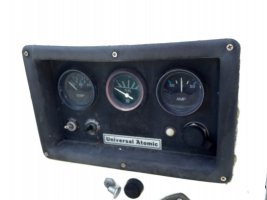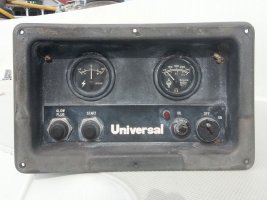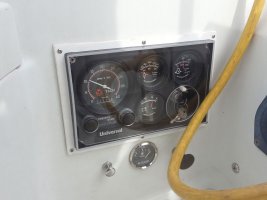jacksonkev
Member III
Sorry in advance for the simplicity (and length) of these questions but Google isn't getting me where I need to be....
I bought a 1981 E30+ with a Universal 5416 (M-20) about a year ago. She was well taken care of by the PO but I'd like to dive into some basic maintenance stuff (and could use a little advice). My old E29 had an Atomic 4 and I did most of the routine maintenance but my diesel engine knowledge is limited at best. I've changed the lubricating oil (10W40) and filter (NAPA 1348) and cleaned the raw water filter element but that's about it so far. So, here are a couple questions...
1. When I changed the oil, I switched from SAE 30 to 10W40. I only got about 2.5-3 quarts out of the dipstick bore with an oil extractor. So, simple math would suggest that I still have about 1 qt. of SAE 30 mixed with the 10W40. Is this bad enough to merit another quick change? Or do I just leave it until next season?
2. Coolant-Do I just top the coolant off or drain and refill? No idea how long it's been. I think I read somewhere that mixing coolants is not a great idea, true? Also, there's an aftermarket coolant overflow tank installed. What's the purpose of the overflow? And when topping off or refilling, do I still top off to the same mark? I've never had a radiator on a boat as my A4 was raw water only cooled.
as my A4 was raw water only cooled.
3. I inspected the alternator belt and it looks pretty worn. So, I bought a Gates 7410 belt (based on Google search). Is there a trick to installing it? I tried once and felt like it was too short. I double checked the part #'s and that seems to be the one. I put the old one back on and retensioned it. Maybe I'm missing something?
4. I'd like to change the fuel oil filter(s) but I'm completely clueless here. Is there a photo diagram online (with parts labeled) for this engine. I Googled every which way and got nothing. I think I have 2 fuel oil filters, 1 near the fuel injector pump and 1 mounted inline on a T between the tank and the engine. Does this sound right or is the bulkhead mounted filter the fuel oil filter (NAPA 3390)? I have no idea what the heck this filter is. It's old and generic looking with no labels or brand ID's. I'm assuming I need to replace it but have no idea except to pull it off. Seems stupid....especially if I can't find one locally.
I think I have 2 fuel oil filters, 1 near the fuel injector pump and 1 mounted inline on a T between the tank and the engine. Does this sound right or is the bulkhead mounted filter the fuel oil filter (NAPA 3390)? I have no idea what the heck this filter is. It's old and generic looking with no labels or brand ID's. I'm assuming I need to replace it but have no idea except to pull it off. Seems stupid....especially if I can't find one locally.
5. For the transmission fluid-do I simply top it off or should I drain and refill? I'm assuming it hasn't been drained in years. If so, I couldn't find any draining instructions online.
6. I read about replacing the heat exchanger zinc, can someone describe this process and where to purchase the proper zinc?
7. Separate of the engine, I've read that there is a potential dangerous electrical situation with regard to ammeters/trailer plugs with some panels. How do I know if I have one of these (see attached photo) and if so, how do I get an electrician to fix it without charging me a king's ransom? I hate working on AC or DC stuff but don't want to get fleeced.
8. Lastly! Is there a recommended maintenance schedule to be performed by a mechanic (outside of the normal routine stuff that I can easily do myself)? The engine starts right up, runs well and there is no smoke but I doubt the PO had many visits from a mechanic. I figured I would do the...
Is there a recommended maintenance schedule to be performed by a mechanic (outside of the normal routine stuff that I can easily do myself)? The engine starts right up, runs well and there is no smoke but I doubt the PO had many visits from a mechanic. I figured I would do the...
-Clean the raw water filter
-Lubricating oil/filter changes
-Fuel filter changes
-Transmission fluid
-Heat exchanger zinc
-Change the raw water impeller
-Coolant
-Check the belt
I'd like to get the next level of inspection/tune up without simply paying a mechanic $300 to check my work. Seeing that the boat is fairly new to me (and I didn't have a mechanic survey the engine while I had the boat surveyed) I'd like to be sure she's running on all cylinders (so to speak...)
Thank you in advance with any advice you might be willing to share!

I bought a 1981 E30+ with a Universal 5416 (M-20) about a year ago. She was well taken care of by the PO but I'd like to dive into some basic maintenance stuff (and could use a little advice). My old E29 had an Atomic 4 and I did most of the routine maintenance but my diesel engine knowledge is limited at best. I've changed the lubricating oil (10W40) and filter (NAPA 1348) and cleaned the raw water filter element but that's about it so far. So, here are a couple questions...
1. When I changed the oil, I switched from SAE 30 to 10W40. I only got about 2.5-3 quarts out of the dipstick bore with an oil extractor. So, simple math would suggest that I still have about 1 qt. of SAE 30 mixed with the 10W40. Is this bad enough to merit another quick change? Or do I just leave it until next season?
2. Coolant-Do I just top the coolant off or drain and refill? No idea how long it's been. I think I read somewhere that mixing coolants is not a great idea, true? Also, there's an aftermarket coolant overflow tank installed. What's the purpose of the overflow? And when topping off or refilling, do I still top off to the same mark? I've never had a radiator on a boat
3. I inspected the alternator belt and it looks pretty worn. So, I bought a Gates 7410 belt (based on Google search). Is there a trick to installing it? I tried once and felt like it was too short. I double checked the part #'s and that seems to be the one. I put the old one back on and retensioned it. Maybe I'm missing something?
4. I'd like to change the fuel oil filter(s) but I'm completely clueless here. Is there a photo diagram online (with parts labeled) for this engine. I Googled every which way and got nothing.
5. For the transmission fluid-do I simply top it off or should I drain and refill? I'm assuming it hasn't been drained in years. If so, I couldn't find any draining instructions online.
6. I read about replacing the heat exchanger zinc, can someone describe this process and where to purchase the proper zinc?
7. Separate of the engine, I've read that there is a potential dangerous electrical situation with regard to ammeters/trailer plugs with some panels. How do I know if I have one of these (see attached photo) and if so, how do I get an electrician to fix it without charging me a king's ransom? I hate working on AC or DC stuff but don't want to get fleeced.
8. Lastly!
 Is there a recommended maintenance schedule to be performed by a mechanic (outside of the normal routine stuff that I can easily do myself)? The engine starts right up, runs well and there is no smoke but I doubt the PO had many visits from a mechanic. I figured I would do the...
Is there a recommended maintenance schedule to be performed by a mechanic (outside of the normal routine stuff that I can easily do myself)? The engine starts right up, runs well and there is no smoke but I doubt the PO had many visits from a mechanic. I figured I would do the...-Clean the raw water filter
-Lubricating oil/filter changes
-Fuel filter changes
-Transmission fluid
-Heat exchanger zinc
-Change the raw water impeller
-Coolant
-Check the belt
I'd like to get the next level of inspection/tune up without simply paying a mechanic $300 to check my work. Seeing that the boat is fairly new to me (and I didn't have a mechanic survey the engine while I had the boat surveyed) I'd like to be sure she's running on all cylinders (so to speak...)
Thank you in advance with any advice you might be willing to share!



